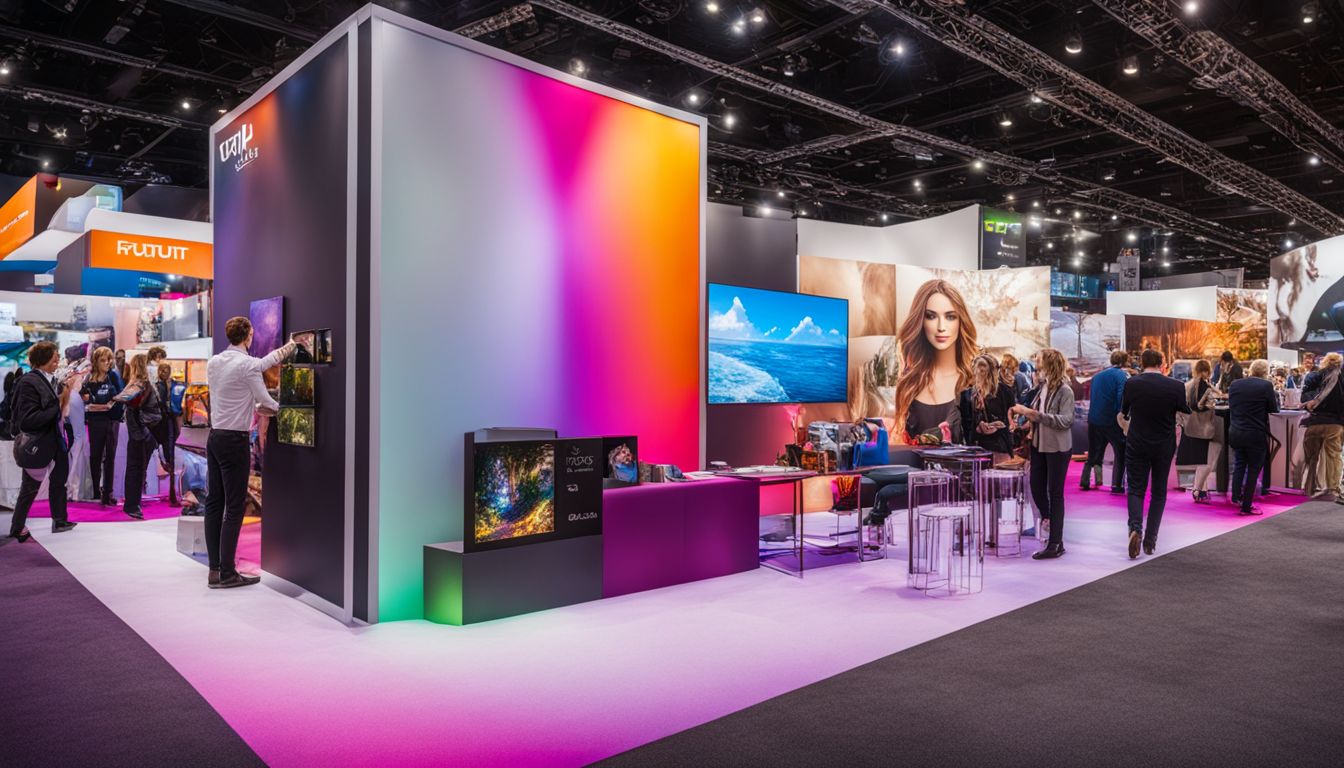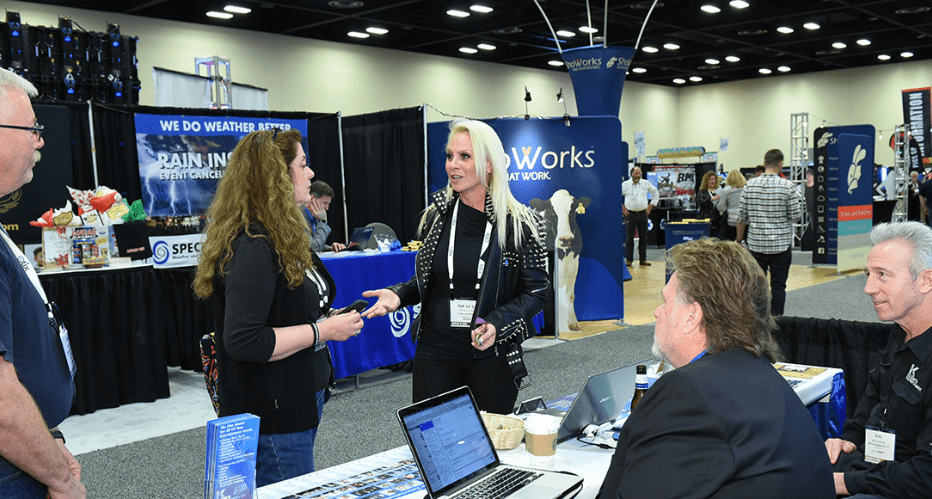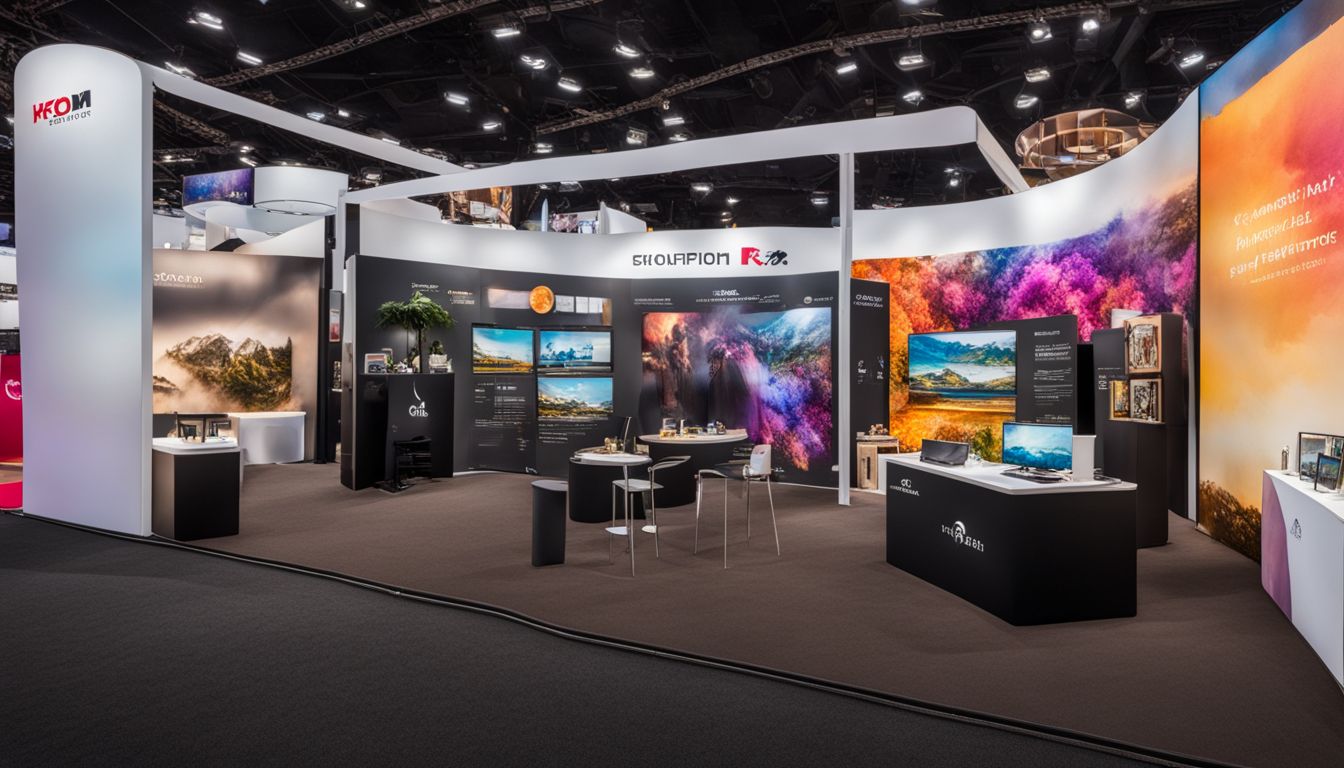Unsure what a trade show is or why it’s significant? It’s an industry-specific event where companies showcase their latest products and services.
This blog will provide you with everything you need to know about trade shows, from their history, purpose, and strategies for success, to how they can benefit your business.
Key Takeaways
- A trade show is an industry-specific event where companies showcase their latest products and services.
- Trade shows have a long history, starting as events to sell and buy goods and evolving into large exhibitions in convention centers or expo halls.
- Participating in trade shows can benefit businesses by providing networking opportunities, market research insights, lead generation, and increased brand awareness.
- To maximize success at trade shows, businesses should set clear goals, carefully select the right shows, design an attractive booth, engage with attendees actively, and evaluate performance for future improvements.
What is a Trade Show?

A trade show is an exhibition where companies from a specific industry come together to showcase their products and services, demonstrate the latest industry trends, and discuss knowledge with other members of the industry.
Definition
A trade show is a big event for businesses. They come to these shows to show off their new products and services. It’s like a big fair, but instead of rides and cotton candy, there are booths with all the latest stuff from different companies.
Everyone in the business world comes together at these shows. They see what’s new, talk about it, and learn from each other.
History
Trade shows have a long past. They started many years ago. People used them to sell and buy goods. Over time, they changed a lot. Today they are big events in huge places like convention centers or expo halls.
Many companies come to these shows now. They show off new products or services there. Sometimes, big news comes out of these trade shows too! The history of trade shows is full of change and growth.
Modern trade shows
Trade shows today are big events. They take place in huge convention centers and expo halls. Many companies from all over the world come to these trade shows. They set up booths where they show off their latest products and services.
At these modern trade shows, you can see a lot of cool things. There are big displays with flashing lights. Some booths have games people can play. Others have talks about new trends in the industry.
These events are not just for business people anymore either, they let everyone come in and learn about what’s new.
The Purpose of Trade Shows

Trade shows serve as a platform for companies to not only display and demonstrate their products and services, but also to discuss industry trends, exchange knowledge, and create new business opportunities in a dynamic environment.
Benefits for businesses
Trade shows offer numerous benefits for businesses. Firstly, they provide a great opportunity to network and connect with industry professionals, potential customers, and partners.
Secondly, trade shows are a valuable platform for market research, allowing companies to gather insights on current trends and competition in their industry. Thirdly, trade shows generate leads by attracting qualified prospects who are interested in the products or services being showcased.
Lastly, trade shows help businesses increase brand awareness by creating a memorable presence through creative displays and engaging demonstrations. Overall, participating in trade shows can be highly beneficial for companies looking to expand their reach and boost sales.
What happens at trade shows
At trade shows, companies come together to showcase their latest products and services. They set up displays and demonstrate how their technology works. Attendees can explore the different booths, talk to company representatives, and learn about industry trends.
Trade shows provide a great networking opportunity for businesses to connect with potential partners or customers. There are often exciting activities happening at trade shows too, like games or giveaways, which help attract attention and make the event more engaging for everyone involved.
How Trade Shows Work

Participating in trade shows requires businesses to carefully select the right shows, plan and design their booth, and allocate a budget for participation.
Cost of participation
Participating in a trade show can come with various costs, such as renting booth space, designing and building your booth, travel expenses, promotional materials, and staffing. These costs may vary depending on the size and location of the trade show.
It is important to plan and budget for these expenses before deciding to participate in a trade show. However, it’s worth noting that the cost of participation can be outweighed by the benefits gained from networking with industry professionals, generating leads, showcasing your products or services to potential customers, and increasing brand visibility.
Selecting the right shows
To ensure a successful trade show experience, it is important to carefully select the right shows. Here are some key factors to consider when choosing which trade shows to participate in:
| Key Factor | Description |
|---|---|
| Target Audience | Look for shows that attract your target audience, such as industry professionals or potential customers. This will increase the chances of valuable connections and leads. |
| Industry Relevance | Choose trade shows that are specific to your industry or related fields. This ensures that attendees have a genuine interest in your products or services. |
| Size and Scale | Consider the size and scale of the trade show. Larger shows may attract a larger number of attendees, but smaller shows can sometimes provide more intimate networking opportunities. |
| Reputation and Track Record | Research the reputation and track record of the trade show organizers. Look for well-established events with a history of successful exhibitor experiences. |
| Cost and ROI | Evaluate the cost of participation relative to the potential return on investment (ROI). Calculate factors such as booth fees, travel expenses, and potential sales or leads generated. |
| Geographic Reach | Determine if the trade show has a regional, national, or international reach. This can impact your ability to expand your business into new markets. |
Designing and preparing for your booth
Designing and preparing for your booth is an important aspect of participating in a trade show. Here are some key considerations:
- Create an attractive booth design that reflects your brand image and grabs attention.
- Use eye-catching visuals, such as large banners or digital displays, to showcase your products or services.
- Arrange your booth layout in a way that encourages flow and allows attendees to easily navigate through the space.
- Make sure your booth is well-lit and properly lit to highlight your offerings effectively.
- Incorporate interactive elements, such as product demos or virtual reality experiences, to engage visitors.
- Choose the right signage and promotional materials that clearly communicate your message and contact information.
- Provide comfortable seating areas or meeting spaces for visitors to have conversations with your team.
- Consider incorporating technology, like tablets or touch screens, to gather attendee information or provide digital content.
- Plan for necessary logistics, such as electricity access, internet connectivity, or storage spaces for samples and materials.
- Train your booth staff on how to present themselves professionally, interact with attendees, and answer questions about your offerings.
Maximizing Success at a Trade Show

To maximize your success at a trade show, set clear goals and objectives, prepare thoroughly for the event, and actively engage with attendees.
Setting goals and objectives
Setting goals and objectives for a trade show is essential for maximizing success and achieving desired outcomes. Here are some key points to consider:
| Key Point | Description |
|---|---|
| Clearly Define Your Purpose | Determine the trade show’s purpose, whether it’s generating leads, increasing brand awareness, or launching a new product. |
| Research the Target Audience | Understand the attendees’ needs and interests to tailor your goals and messaging accordingly. |
| Set Measurable Goals | Establish specific, quantifiable objectives that can be tracked and evaluated post-event, such as lead collection or sales targets. |
| Create an Engaging Booth Experience | Design your booth layout and visuals to attract attendees and effectively showcase your products or services. |
| Train Your Staff | Equip your team with product knowledge and effective communication skills to engage with potential customers. |
| Develop a Pre-Show Marketing Plan | Promote your participation in advance through various channels like social media, email marketing, and targeted advertising to generate buzz around your brand. |
| Schedule Meetings in Advance | Utilize the trade show’s networking opportunities by arranging meetings with key prospects or industry contacts before the event starts. |
| Track Leads and Follow Up Promptly | Have a system to capture lead information during the event and follow up quickly while engagement is fresh. |
| Evaluate Your Performance | Assess how well you achieved your goals by analyzing metrics like sales, customer feedback, or new partnerships established. |
| Learn from Each Experience | Use insights gained from each trade show to refine your strategies for future events, continuously improving your presence and results. |
Preparing for the show
Preparing for a trade show is essential for success. Here are some key steps to follow:
- Set clear goals and objectives for the trade show.
- Research the trade show to understand the target audience and their interests.
- Design an eye-catching booth that represents your brand and product/service.
- Create engaging marketing materials, such as brochures and banners, to attract attendees.
- Train staff members on product knowledge and effective communication skills.
- Develop a checklist of everything you need for the show, including equipment, samples, and promotional items.
- Promote your participation in the trade show through social media, email marketing, and other channels.
- Schedule meetings with potential clients or partners in advance to maximize networking opportunities at the show.
- Prepare a script or talking points to help staff members convey key messages about your products/services.
- Test all equipment and technology before the trade show to ensure smooth operations.
Engaging with attendees
During a trade show, it’s important for exhibitors to engage with attendees in order to make the most out of their participation. Engaging with attendees means actively interacting and connecting with them to promote your products or services.
This can be done through various ways such as offering live demonstrations, providing informative sessions, and conducting interactive activities at your booth. By engaging with attendees, you have the opportunity to create brand awareness, build relationships, and generate leads.
It’s essential to listen to their needs and provide relevant solutions while showcasing the unique features of your offerings. Engaging with attendees not only helps you stand out from competitors but also allows you to gather valuable feedback and insights that can contribute towards improving your products or services in the future.
Remember:
– Actively interact and connect with attendees
– Offer live demonstrations and informative sessions
– Conduct interactive activities at your booth
– Listen to attendee needs and provide relevant solutions
After the Show
After the show, it is crucial to follow up with attendees and analyze the results to measure the success of your trade show participation.
Follow-up and analysis
After the trade show, there are important steps to take for follow-up and analysis. Here’s what you need to do:
| Important Step | Description |
|---|---|
| Collect Contact Information | Gather the contact details of potential leads and customers you met at the trade show. |
| Send Personalized Emails | Reach out to each lead individually with a personalized email, thanking them for visiting your booth and expressing interest in their needs. |
| Follow Up Promptly | Don’t wait too long before getting in touch with leads. Promptly respond to inquiries and provide any requested information. |
| Nurture Leads | Create a plan to nurture leads through regular follow-ups, such as sending targeted content or offering exclusive discounts. |
| Analyze Sales Data | Dive into the sales data from the trade show to measure your success. Look at factors like conversion rates, revenue generated, and return on investment (ROI). |
| Review Attendee Feedback | Assess any feedback received during or after the trade show to understand areas where you can improve your future exhibitions. |
| Evaluate Goals and Objectives | Compare your actual results with the goals and objectives you set before the trade show. Identify any gaps or areas for improvement. |
| Adjust Strategies for Future Shows | Use the insights gained from analyzing your trade show performance to refine your strategies for future events. |
| Share Learnings Internally | Communicate your findings and learnings with key stakeholders within your company to inform future marketing efforts and exhibition decisions. |
| Continue Nurturing Relationships | Even after the trade show is over, continue building relationships with leads and prospects through ongoing communication channels like email newsletters or social media engagement. |
Measuring results
After the trade show is over, it’s important to measure the results of your participation. This involves analyzing various metrics to assess the success of your booth and overall marketing efforts.
You can measure things like the number of leads generated, sales made during or after the show, and customer feedback received. Additionally, you can track website visits and social media engagement to gauge online impact.
By measuring these results, you’ll be able to determine if the trade show was a worthwhile investment for your technology company and make informed decisions for future events.
Conclusion
In conclusion, a trade show is an exhibition event where companies come together to showcase their newest products and services. It’s an opportunity for businesses to display, demonstrate, and discuss their offerings with industry members and the public.
Trade shows serve as valuable marketing platforms that provide networking opportunities and generate leads for businesses. So if you want to make a splash in your industry, participating in a trade show can be a successful way to do it.
Frequently Asked Questions
What is a trade show?
A trade show is an event where businesses from a specific industry gather to showcase their products or services to potential buyers and customers.
Why should I attend a trade show?
Attending a trade show can provide valuable networking opportunities, allow you to see the latest trends in your industry, and help you promote your own business.
How do I participate in a trade show?
To participate in a trade show, you need to register as an exhibitor or attendee, pay any required fees, and prepare your booth or promotional materials if you are exhibiting.
Are trade shows open to the public?
Trade shows are usually not open to the general public. They are primarily intended for professionals within the industry and require registration or invitation for attendance.
How can I make my booth stand out at a trade show?
You can make your booth stand out by creating an eye-catching display with attractive signage, interactive elements, product demonstrations, and engaging staff members who can effectively communicate with visitors.




